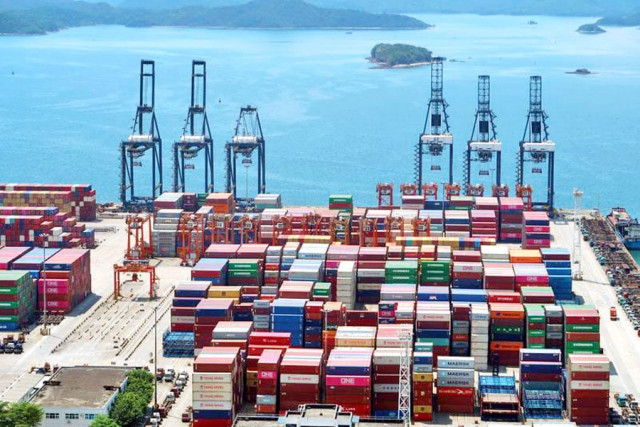Lacing exports with GI tags
Products with GI tag fetch much higher price than those without such identity

Do you know what is common among Pakistan’s Basmati rice, Hunza/ Ziarat apples, Multan’s Chaunsa mango, Kashmiri Pashmina, Khewra pink salt, Sialkot sports and surgical goods and Sahiwal cattle?
These are goods produced in certain areas of Pakistan and are unique. They are not produced anywhere in the world. But does the world recognise their status?
That’s important to know because unless the world recognises them as such, Pakistan cannot market them in global markets, claiming they are produced only in this country.
In other words, Pakistan needs the Geographical Indication (GI) tag for these and many other unique goods – and even services like the famous truck art.
Once Pakistan starts marketing these goods and services to the world under the GI tag to be issued by the country, but not contested and brought into conflict by any other producer of any other area of the world, the country can earn a lot of foreign exchange.
The Ministry of Commerce has identified two dozen products of Pakistan including Basmati rice that are unique enough to get the GI tag. The question is how they will get the GI tag.
Well, back in 2020, Pakistan came up with the GI Registration and Protection Act and since then efforts have been made to provide these products the GI tag they deserve.
For this purpose, the Intellectual Property Organisation of Pakistan (IPO-Pakistan) has already initiated the process of establishing the Geographical Indication Registry.
Currently, the trade marks registry officers are busy carrying out the spadework for the GI Registry, which is expected to start functioning under IPO-Pakistan in current fiscal year 2021-22.
It is difficult to assess the possible volumetric gains in exports after all 24 products that deserve the GI tag get them. But given the fact that the list of these items include export heavyweights like Basmati rice, mangoes and sports and surgical items, one can safely assume that the total annual gains can reach a billion-dollar mark – or even surpass it.
Combined exports of these three categories of items currently stand close to $2 billion. However, total export earnings of the other 21 items are less than half a billion dollars.
Once the GI tag is applied to all of them, Pakistan’s export earnings of less than $2.5 billion from these two dozen products can rise to $3.5 billion a year in the very first year of GI tag application.
Going forward, the increasing cumulative export earnings will depend largely on how the Ministry of Commerce, Pakistan’s foreign trade missions and exporters manage to market these GI-tagged products around the world.
Generally speaking, a product with the GI tag – not brought into international dispute and accepted as such – fetches a much higher per unit price than the similar products without GI tags.
Lacing exports with GI tags, rolling out seductive and powerful brands and marketing them aggressively decidedly boost exports.
Over the past two decades, India, Vietnam, Indonesia, Malaysia and Bangladesh all have done that. And that has resulted in several times increase in their export earnings.
Brand power
In Pakistan, about a dozen textile exporters have created, and are maintaining, their brand power. Among them are Afroze, Alkaram, Artistic Milliners, Artistic Fabric & Garment Industries, Feroze 1888 Textile Mills, Gul Ahmed, Garibsons, Interloop, Liberty Textiles, Nishat, Soorty Enterprises, Style Textiles and Younus Textile Mills.
According to the All Pakistan Textile Mills Association, almost all of these companies fetched more than $100 million in exports in the just-ended fiscal year.
A similar brand power needs to be created, and maintained, in rice, fish and seafood and meat exports as well.
But sadly, in these categories of exports, we don’t see enough branding. Seafood exporters and the government must strive for getting the GI tag for certain types of fish that are found only in Pakistani rivers and in the territorial waters of Pakistan.
Besides, the seafood processing industry needs to be upgraded. Technical assistance can be sought from Indonesia that has achieved many milestones in seafood exports over the last decade with the result that per unit export price of its fish and seafood is way higher than that for Pakistan’s products.
Coming back to the issue of lacing exports with GI tags, two aspects need to be put in perspective.
The indifferent attitude of government agencies towards earning GI tags for potential Pakistani products does not only keep export earnings from rising fast and sustainably, it also deprives the economy of greater number of jobs in rural and semi-urban areas, and stunts the growth of small and medium enterprise (SME) sector.
More unique products
Among Pakistan’s unique products that are best candidates for winning the GI tag are Sindhi Topi and Ajrak, truck art, Chitrali embroidery, Gujranwala pottery, Multan blue pottery, Gujranwala coloured pottery, Swat peaches and Peshawari Chappal (sandles) – and perhaps more importantly Kalash dress.
Do you notice that these products come from all provinces and federating units of Pakistan?
If they actually get the GI tag and their exports jumpstart, the rural and semi-urban areas of all provinces and federating units that produce them would get an economic boost in terms of greater job opportunities and higher income levels.
But even after getting the GI tag for them and other unique products, Pakistan will have to do a lot more to promote manufacturing and trading SMEs to ensure a high and sustainable growth of these GI-decorated as well as other similar items of exports.
Unfortunately, despite tall claims of every government about promoting the SME sector, a very large number of small and medium units continue to run in the undocumented sector.
Even amongst those that operate in the formal sector, not many can manage to get bank financing. Bank financing to the SMEs remains pathetically low.
According to State Bank statistics (for May 2021), bank financing to the SMEs accounts for just 8.8% of the total bank financing to private sector businesses.
THE WRITER IS A MECHANICAL ENGINEER AND IS DOING MASTERS












1726134115-0/BeFunk_-(41)1726134115-0-208x130.webp)






COMMENTS
Comments are moderated and generally will be posted if they are on-topic and not abusive.
For more information, please see our Comments FAQ